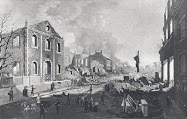Robert M. Solow, Groundbreaking Economist and Nobelist, Dies at 99
Robert M. Solow in 1987, when he won the Nobel Memorial Prize in Economic Sciences.
Photo Credit: Mark Lennihan/Associated Press
Robert M. Solow, who won a Nobel in economic science in 1987 for his theory that advances in technology, rather than increases in capital and labor, have been the primary drivers of economic growth in the United States, died on Thursday at his home in Lexington, Mass. He was 99.
His son John confirmed the death.
Professor Solow (pronounced solo) taught at the Massachusetts Institute of Technology, where he and a fellow Nobel laureate, Paul A. Samuelson, forged the M.I.T. style of economic analysis, which emerged as a leading approach in the second half of the 20th century and played an important role in economic policymaking.
His work demonstrated the power of bringing mathematics to bear on important economic debates and simplifying the analysis by focusing on a small number of variables at a time.
Beyond the impact of his own research, Professor Solow helped launch the careers of a stunning number of future superstar economists, including four Nobel laureates: Peter Diamond, Joseph E. Stiglitz, William D. Nordhaus and George A. Akerlof. “My pride and joy,” Professor Solow said.
The affection was reciprocated. In an interview for this obituary in 2013, Alan S. Blinder, a Princeton University economics professor, a former deputy chairman of the Federal Reserve Board and a Solow pupil, said, “All his former students idolize him — all, with no exceptions.”
Professor Solow received the John Bates Clark Medal in 1961 as the finest American economist under 40 and the National Medal of Science in 1999; he was one of the few economists to receive that honor. In 2014, President Barack Obama awarded him the Presidential Medal of Freedom, the nation’s highest civilian honor.
Professor Solow’s research on economic growth became the model by which economists, well beyond the confines of M.I.T., came to practice their craft. For a century or more they simply “knew” that growth of capital and labor determined economic growth. But Professor Solow could not find data to confirm that common-sense presumption.
Besides, academic theories of economic growth that predated his writings had the discomforting implication that capitalist economies were always teetering between boom and bust. He observed that “the history of capitalism didn’t look like that.”
So what did explain growth? Entrepreneurs? Geography? Legal institutions? Something else?
“I discovered to my great surprise that the main source of growth was not capital investment but technological change,” Professor Solow said in an interview in 2009, also for this obituary. Specifically, he estimated that technical progress accounted for a surprising 80 percent of 20th-century American growth. He later pointed to Silicon Valley as a validation of his theory.
Technology Was Key
Professor Solow’s strategy — his gimmick, he liked to say — was to pick out one thing of special interest and simplify the role of everything else. The goal was to understand completely the role of a “little piece of the puzzle.” This strategy of inquiry came to be known as building “toy models.”
In analyzing economic growth, he singled out technological progress (the ability of society to translate inputs of capital and labor into outputs of goods and services) as independent from the other key variables, including population growth and returns on capital.
He devised a graph with two curves. One captured his simplifying assumption that population growth and technological knowledge rise at a constant rate over time. The second one captured his all-important assumption that the economic impact of adding more and more capital gets weaker and weaker. Adding capital to an economy drives up total output, but each additional dollop of capital drives up output by less than the previous dollop did.
Put the two curves on the same graph and a powerful theory of growth emerged. Professor Solow showed that higher savings and investment would indeed make individuals richer on average — the level of income per person would rise. But the added savings and investment would not affect the economy’s long-term rate of growth. The impact of additional savings on permanent growth rates peters out in a way that, under Professor Solow’s assumption, the impacts of population and technical knowledge do not.
Out went 100 years of often fruitless, meandering debate. Professor Solow’s simple graph refocused the argument, providing a clear path to cause-and-effect statements about past and future growth. He published his growth model in 1956. At that point, he had provided an elegant theory. A year later, he presented evidence.




No comments:
Post a Comment